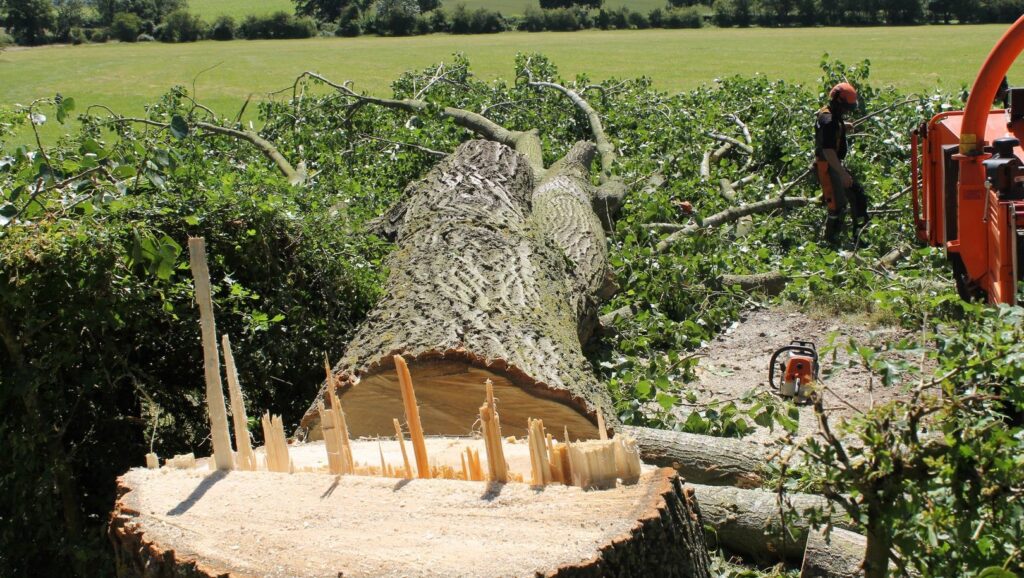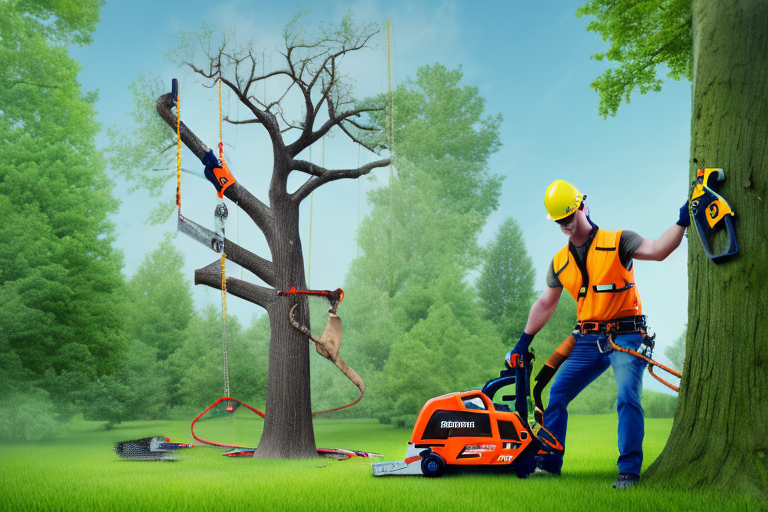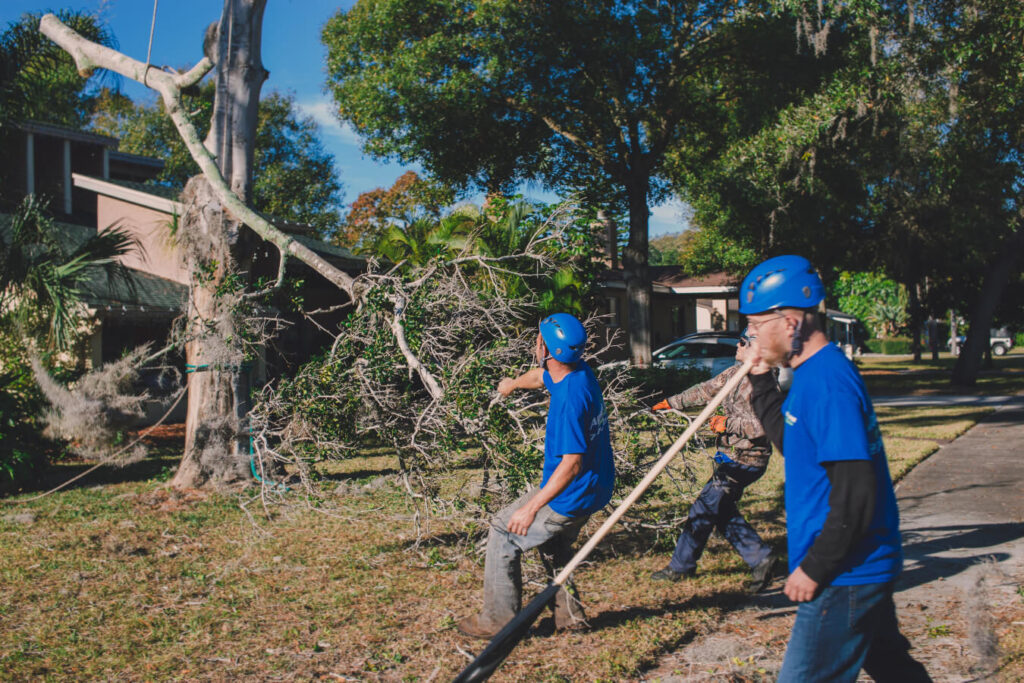Trees are a beautiful addition to any landscape. They provide shade, beauty, and even fruits. However, there are instances when tree removal becomes necessary. Whether it’s due to disease, damage, obstruction, or aesthetics, understanding the basics of tree removal is crucial for homeowners. In this guide, we will explore the process of professional tree removal, how to select a reliable tree removal service, and the necessary steps to prepare your property for tree removal. Let’s dive in!
Understanding the Basics of Tree Removal
Tree removal is a complex process that requires careful consideration and expertise. It is often necessary to ensure the safety of your property and loved ones. Trees affected by diseases or infestations can pose a threat, as they may weaken and fall, causing damage to structures or even endangering lives. Additionally, trees that obstruct power lines or interfere with the growth of other plants may need to be removed to maintain a healthy and balanced ecosystem.
When it comes to tree removal, it is important to understand the various factors involved. Identifying trees that require removal is the first step. Look for signs such as significant decay, large dead branches, leaning trunks, root damage, or extensive pest infestations. These issues indicate a compromised tree that may need to be removed sooner rather than later.
Once you have identified a tree that needs to be removed, it is crucial to assess the risks involved. Tree removal can be a dangerous task, especially without the proper knowledge and equipment. Falling branches or trees, power line accidents, and injuries from chainsaws are just a few of the potential hazards. Therefore, hiring a professional tree removal service is highly recommended.
Professional tree removal services have the expertise and experience to safely remove trees. They have the necessary equipment, such as cranes and chainsaws, to efficiently and effectively remove trees without causing any harm. They also have the knowledge to assess the situation and determine the best approach for tree removal, taking into consideration factors such as the tree’s size, location, and surrounding structures.

When hiring a tree removal service, it is important to choose a reputable and qualified company. Look for certifications and licenses, as well as positive reviews and testimonials from previous clients. Additionally, make sure the company has insurance coverage to protect you and your property in case of any accidents or damages during the tree removal process.
Overall, understanding the basics of tree removal is essential for maintaining a safe and healthy environment. By being aware of the signs that indicate a tree needs to be removed and the risks involved in DIY tree removal, you can make informed decisions and ensure the well-being of your property and loved ones.
Related: The Basics and Benefits of Stump Grinding
The Process of Professional Tree Removal
Tree removal is a complex process that requires careful assessment, planning, and execution. Professional arborists are trained and equipped to handle this task efficiently and safely. Let’s take a closer look at the various stages involved in the process.
Initial Assessment and Planning
Before the tree removal process begins, a professional arborist will conduct a thorough assessment of the tree and the surrounding area. This evaluation helps them determine the best approach for removal, taking into consideration factors such as the tree’s condition, its location, and any potential obstacles. The arborist will inspect the tree for signs of disease, decay, or structural instability. They will also assess the proximity of buildings, power lines, and other structures to ensure a safe removal process.
Based on their assessment, the arborist will develop a detailed plan for the removal. This plan will outline the specific techniques and equipment required to safely and efficiently remove the tree. Proper planning is essential to minimize risks and ensure a successful removal.
Cutting Techniques and Equipment
Once the assessment is complete and the removal plan is in place, the arborist will carefully execute the plan using specialized equipment and cutting techniques. Different trees may require different methods, such as sectional cutting or felling, to ensure a controlled and safe removal process.
Sectional cutting involves removing the tree in smaller sections, starting from the top and working downwards. This technique is often used when there are obstacles nearby or when the tree is in a confined space. Felling, on the other hand, involves cutting the tree at the base and allowing it to fall in a predetermined direction. This method is suitable for trees with ample space and no obstructions.
Professional arborists have the knowledge and experience to employ these techniques effectively. They use specialized equipment, such as chainsaws, ropes, and rigging systems, to safely cut and remove the tree. Safety precautions, such as wearing protective gear and using proper climbing techniques, are always followed to minimize the risk of accidents.

Stump Removal and Cleanup
After the tree is felled and removed, the arborist will address the remaining stump. Stumps can be unsightly and can also pose tripping hazards, so it’s important to remove them properly.
The arborist will determine the most suitable stump removal technique based on factors such as the size and location of the stump. Grinding is a common method used for smaller stumps. A stump grinder is used to chip away at the stump until it is below ground level. For larger stumps or those in sensitive areas, full excavation may be necessary. This involves digging out the entire stump, including the root system.
Thorough cleanup is then conducted to remove any debris and restore the area to its original condition. The arborist will remove all branches, twigs, and other tree remnants from the site. They will also rake and level the ground, ensuring that no trace of the tree removal process remains.
Tree removal is a task that should always be left to the professionals. Hiring a certified arborist ensures that the process is carried out safely, efficiently, and in compliance with local regulations. If you have a tree that needs to be removed, contact a reputable tree care company to schedule an assessment and discuss your options.
Selecting a Tree Removal Service
When it comes to selecting a tree removal service, there are several important factors to consider. Not only do you want to ensure that the service provider is qualified and reliable, but you also want to make sure that they adhere to industry standards and practices. In this article, we will explore some key credentials to look for, questions to ask potential services, and factors to consider when it comes to cost.
Credentials to Look For
One of the first things you should look for when selecting a tree removal service is their credentials. Certifications from professional organizations such as the International Society of Arboriculture (ISA) or the Tree Care Industry Association (TCIA) can provide you with peace of mind knowing that the service provider has met certain standards of expertise and professionalism. These certifications ensure that the service provider has the necessary knowledge and skills to safely and effectively remove trees.
Additionally, you may want to inquire about any other relevant certifications or licenses that the service provider holds. For example, if you live in an area where certain tree species are protected, you may want to ensure that the service provider has the necessary permits to legally remove those trees.

Questions to Ask Potential Services
Before making a final decision, it is important to ask potential tree removal services a series of questions to ensure their reliability and expertise. Here are some important questions to consider:
- How much experience do you have? It is important to choose a service provider with a proven track record of successfully removing trees. Ask about their experience in the industry and if they have any specialized expertise.
- Do you have insurance coverage? Tree removal can be a risky job, so it is crucial that the service provider has the necessary insurance coverage to protect both themselves and you as the homeowner. Ask for proof of insurance and make sure it is up to date.
- What equipment do you use? The equipment used by the service provider can greatly impact the efficiency and safety of the tree removal process. Inquire about the type of equipment they use and whether it is well-maintained.
- What safety protocols do you follow? Safety should always be a top priority when it comes to tree removal. Ask about the safety protocols the service provider follows to ensure that they take the necessary precautions to protect both their workers and your property.
- Can you provide references? Requesting references from past clients can give you valuable insight into the quality of the service provided. Reach out to these references and ask about their overall satisfaction with the service.
Understanding Cost Factors
When it comes to the cost of tree removal, there are several factors that can influence the overall price. Some of the key factors to consider include:
- Size and condition of the tree: Larger and more complex tree removals may require additional equipment and manpower, which can increase the cost.
- Accessibility: If the tree is located in a hard-to-reach area, such as a backyard with limited access, it may require more time and effort to remove, resulting in higher costs.
- Pricing structure: Different service providers may have different pricing structures. Some may charge a flat fee, while others may charge based on the size and complexity of the job. It is important to understand the breakdown of costs and compare quotes from multiple providers.
While cost is an important factor to consider, it should not be the sole determining factor in your decision-making process. Choosing a reputable service provider based on their expertise, reliability, and adherence to safety standards should be a priority. Remember, investing in a qualified and professional tree removal service can help ensure the safety of your property and the surrounding environment.
Preparing Your Property for Tree Removal
Safety Measures to Consider
Prior to tree removal, it is crucial to prioritize safety. Ensure that children and pets are kept away from the work area. Additionally, clear any potential obstacles or hazards that may hinder the removal process, such as vehicles or fragile objects. By taking these safety measures, you help create a secure environment for the arborists and minimize the risk of accidents.
Legal Permissions and Restrictions
Before removing a tree, check with your local municipality or homeowner’s association to determine if any permissions or permits are required. Some locations may have restrictions or regulations regarding tree removal, especially if the tree is protected by law. It is important to comply with these regulations to avoid legal issues.
Post-Removal Landscape Restoration
Once the tree is removed, you may want to consider the restoration of your landscape. Consult with an arborist or a landscaping professional to determine the best course of action. They can provide advice on planting new trees, shrubs, or flowers to enhance the beauty of your property.
As a homeowner, understanding the art of expert tree removal is essential for maintaining a safe and appealing environment. By recognizing the signs that necessitate tree removal, selecting a reliable tree removal service, and preparing your property accordingly, you can ensure a smooth and successful tree removal process. Remember, safety should always be the top priority!
Categories: Tree Removal Services